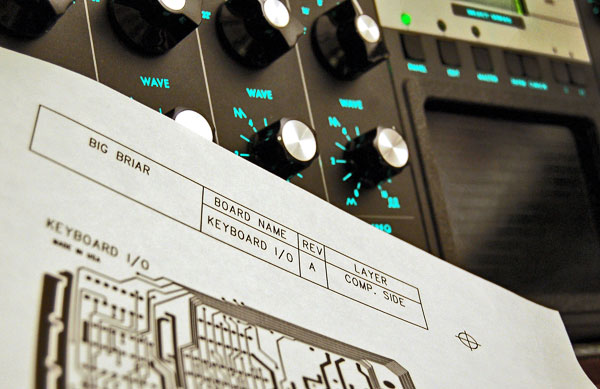From Bach to Yes, early exposure to new sonic possibilities changed Chris Stack’s life.
“More than anything, the use of these new electronic instruments opened my eyes to the possibilities of using technology to create works that embodied new artistic goals and new aesthetic philosophies. Suddenly, anything was possible.“

Ive been a firm believer in the mission of the Bob Moog Foundation since I first became aware of its existence. The effects of Bobs legacy of music, science and imagination kick-started my intellectual life at an early age and has been a constant source of inspiration ever since. I believe in the foundations work because I know from personal experience the profound and positive benefits it can have.
It all started many years ago, back in 1969 in an elementary school music class in the Atlanta suburbs. One day as a change from our usual routine of singing the blander top hits of the day (Raindrops Keep Falling On My Head anyone?), the teacher brought in a new album for us to listen to. We all groaned when she told us it was classical music, but as she talked more about it I was intrigued. It was called Switched-On Bach and it was classical music played by Walter (later Wendy) Carlos on a new electronic instrument called a synthesizer. There was still some groaning, but those of us who were Star Trek fans (a new TV show at the time) were paying attention.
Then the music started. Thinking back on it now, its hard to describe that experience. Today we can do pretty much anything we want to with sound. You want a sound that morphs between a bagpipe and a backwards bullfrog? No problem. There are new sounds in almost every pop song you hear. Not so back then. Almost every song we heard on television, the radio or our record players in those days was created from the same limited tonal palette. Not so with this album. It was ancient music played on an instrument from outer space and it was made from sounds we didnt even know could exist. Like isolated islanders seeing tall ships sail into our bay for the first time, we almost didnt know how to perceive them, but we were transfixed. The teacher told us about Bach and counterpoint. I was so deeply engrossed in the music that I only half heard her, and for years I thought that counterpoint was a characteristic of electronic music, not baroque music.
She then told us about how the music was created with the Moog synthesizer. That name even sounded like it came from outer space. This was obviously the coolest thing in the world. Not long afterwards I saw Micky Dolenz playing one on The Monkees Saturday morning TV show. You could play more than just classical music on a synthesizer? Now we were really on to something.
I should mention that my scholastic achievements up to this point had been less than stellar far less than stellar, actually. My report cards usually contained an equal sprinkling of Cs, Ds and Fs. My sisters were both making straight As. I just was not interested in much that they were teaching in school those days. Im not sure why diagramming sentences didnt appeal to me and maybe I would have been more interested in the main rivers of India if like now, I actually knew some Indians.
Unfortunately, inspirational experiences like the Switched-On episode were pretty rare for a couple of years. The next big one came along when I was in the 10th grade in 1973. A friend loaned me an album he thought I would like. It was Close To The Edge by YES. This one peeled my ears open even wider than Switched-On Bach had. Here was a Moog synthesizer again. This time it was not just making new sounds, but it was playing a kind of music that I never imagined was possible. That Bob Moog guy was still making cool stuff.
The music was built on elements of rock but contained so much more classical, spiritual, even ragtime. More than anything, the use of these new electronic instruments opened my eyes to the possibilities of using technology to create works that embodied new artistic goals and new aesthetic philosophies. Suddenly, anything was possible.
Along with this new genre of progressive rock, the success of Switched-On Bach spawned a whole new wave of electronic realizations of classical music compositions. Japanese synthesist Isao Tomitas Snowflakes Are Dancing showed that synthesizers (in this case, another big Moog modular) in classical music were not just limited to baroque precision; they were also the perfect tools for the performance of Claude Debussys 20th century impressionistic tone poems. Tomitas follow-up recordings of Stravinskys Firebird Suite, Mussorgskys Pictures At An Exhibition (also covered by prog rockers Emerson, Lake & Palmer) and Holsts The Planets provided a painless introduction to modern classical music, a genre that I previously was not aware existed. Before long, my friends and I were having discussions on topics ranging from orchestration to the social and historical context of these works.
At that point I decided to learn all that I could about these Moog synthesizers. Unfortunately, this was well before the Internet. It was difficult to get current information about anything like this, especially in South Carolina where I was living then. I would occasionally see bits and pieces about them in the newspapers or on television, and one day I found an address where I could send off for some information on synthesizers made by another company called ARP. I read those brochures for the 2500, 2600, Odyssey and Pro Soloist from cover to cover, over and over again. There were a lot of concepts on them that I didnt understand but even though these concepts looked a lot like math and science, I wanted to know more.
A funny thing started to happen then. My grades got a lot better. Where before I was barely passing each year, in the 11th and 12th grade I brought home a nice smattering of As and Bs, much to my parents relief.
The education bug was planted but unfortunately did not yet have a strong foothold. I went to a local college for a year but could not settle on a major that interested me. This was 1976 and the phrase personal computer had not yet been coined. It was the age of large mainframes programmed with punch cards and while vaguely interesting; they were not obviously useful enough to hold my interest.
I wound up dropping out after a year and entering the unskilled industrial workforce. The bright point of this period was that it coincided with the first appearances of affordable synthesizers. The Minimoog, while affordable compared to the original modulars, had been out for a while at that point but was still financially out of my reach. Other new brands were showing up though. The Japanese were getting into manufacturing just about everything then, and synthesizers were no exception.
To see Part 2 of the series please click here.
To see Part 3 of the series please click here.
To see Part 4 of the series please click here.
For more from Chris Stack visit his YouTube Channel or his website, ExperimentalSynth.com.


Boy, did this post take me back! It was in about 1969 that I too was exposed to Switched-On Bach in a high school music class, and I was hooked. I ended up at Dartmouth, where composer and professor Jon Appleton (and guest composer Lauren Levy from Columbia) offered courses in electronic music in the Bregman Electronic Music Studio in the basement of one of Dartmouth Row’s buildings. The Moog synth, consoles and tape decks took up most of the roughly 15′ x 30′ room, and it was a music geek’s fantastic playground. I wish I knew how to retrieve tapes of my compositions from those two engaging courses, one of which was a piece of musique concrete made up from samples of the vibrating bed spring in my dorm room. On one field trip our class visited Bell Labs, where Max Matthews was working on voice synthesis, and the music studio at Columbia University, and we had dinner that night at Matthews’ house, where his friend, composer Vladimir Ussachevsky, serenaded us on the piano. Just incredible…While I didn’t pursue a musical career (talked out of that by my more practical parents), I’ve always loved electronic and all other forms of contemporary “serious” music and recall how liberating the creativity inspired by my Dartmouth musical experience was. I look forward to the eventual opening of the Moogseum in Asheville.
For me it was early 70’s, ELP Pictures at an Exhibition, Rick Wakeman six wives. Started electronics 6th grade. By end of 70’s was building divider organs, Modular systems for friends ( I never could afford to build for myself) – discretes, CEM chips etc. 30 years later I have resurected my electronics to show my kids. Bought a Moog Opus 3 on Ebay last week and serviced it by removing the decomposing foam – aka tar, removed the sliders and cleaned them. And the Moog Opus 3 is a divider organ ! I am having a blast !!
Peter,
I just heard the orchestral version of Pictures at an Exhibition again a couple days ago. The themes in it are some of the best melodies in classical music and they translate really well into other types o music.
I was a “Six Wives” fan too. I remember reaching a turning point in my life when one day I realized that I liked my keyboard setup better than Wakeman’s shown in the center panels of the album art.
Glad to hear you are diving back into electronics. Sounds like it’s time to build yourself a modular.
I can’t recall where I first heard electronic music, but still have many many audio clips in memory of parts from soundtracks, radio play of songs and commercials: assorted sci fi soundtracks, Dr Who, “Telstar”, “Good Vibrations”, local Byrzynski’s bakery commercial from Bufflalo, 7up commercial [ filament in green lightbulb flicking, seemingly in time to synthesizer track], all throughout the 60’s and early 70’s. No clear idea on when I was “introduced” to Switched on Bach in the era when it was introduced, but later on found a copy in the mid 70’s college library of Wendy(Walter) Carlos version of Clockwork Orange and was blown away by the long form version of “Timesteps”, having listened to the mainstream soundtrack dozens of times over. Most vivid memory though was attending an arranged concert circa 1969 at McMaster University with my junior school. Hamilton Philharmonic, someone from the University with what would likely have been a Moog P3 connected to a computer(!) and a local hippie-pop-vocal group Tranquility Base (yes moon landing referenced). We were treated to three versions of the same composition interpreted by each ensemble. Seminal moment but I had been a keen observer for years of sounds of this class of instruments. Even though we were close to Moog in Bufflalo (I had no idea), as you had mentioned street addresses to reach out to get information on synthesizers was not readily available. It took years to lay hands on anything tangible to explain their inner workings. Our TV was dead for about a year forcing me to embrace the public library but pickings were slim and not up to date, mostly “music concrete”, Stockhausen, Iannis Xenakis. To only be able to read and not hear examples of the music and composers being described was excruciating, let alone not being able to reach out beyond the boring home organs in the neighbourhood and see such machines in person.